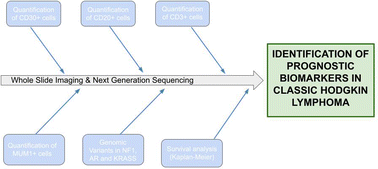Identification of prognostic factors in classic Hodgkin lymphoma by integrating whole slide imaging and next generation sequencing†
Abstract
Digital pathology and genomics are increasingly used to improve our understanding of lymphoid neoplasms. Algorithms for quantifying cell populations in the lymph node and genetics can be integrated to identify new biomarkers with prognostic impact in classic Hodgkin lymphoma (cHL). In 16 cHL patients, we have performed whole slide imaging (WSI) analysis and quantification of CD30+, CD20+, CD3+ and MUM1+ cells in whole tissue slides, and Next Generation Sequencing (NGS) in formalin fixed paraffin-embedded (FFPE) tissue, using a widely used NSG panel (Oncomine® Focus Assay) to define genetic variants underlying tumor development. The different cell populations could be successfully identified in scanned slides of cHL, supporting the inclusion of WSI in the histopathological evaluation of cHL as an adequate method for the quantification of different cell populations. We also performed genetic profiling in FFPE samples of cHL leading to the identification of copy number variations in the Neurofibromin 1 gene (17q11.2) and the Androgen Receptor gene (Xq12) accompanied by chromosomal gains and losses in CDK4, KRAS and FGFR2 genes. Progression-free survival (PFS) was statistically significantly higher in cHL patients with amplification in the NF1 gene combined with CD3+ cells above 28.6% (p = 0.006) and MUM1+ cells above 21.8% (p < 0.001). Moreover, patients with MUM1+ cells above 21.8% showed a statistically significantly higher PFS when combined with amplification of the AR gene (p < 0.001) and wild-type KRAS (p < 0.001). The integration of WSI analysis and DNA sequencing could be useful to improve our understanding of the biology of cHL and define risk subgroups.



 Please wait while we load your content...
Please wait while we load your content...